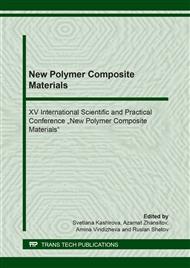[1]
I.A. Novakov, O.M. Novopoltseva. Azomethine: the practical application in chemical industry and medicine // Collection of scientific articles: Chemistry and technology of organ element monomers and polymeric materials. Volgograd. 2003. - P.3-28.
Google Scholar
[2]
G. Liu, Y. Chen, R-W Li, B. Zhang, E.-T. Kang, C. Wang, X. Zhuang, Resistance-Switchable Graphene Oxide-Polymer Nanocomposites for Molecular Electronics, ChemElectroChem. 1 (3) (2014) 514-519.
DOI: 10.1002/celc.201300158
Google Scholar
[3]
A. Ganguly, P. Chakraborty, K. Banerjee, S.K. Choudhuri. The role of a Schiff base scaffold, N-(2-hydroxyacetophenone) glycinate in overcoming multidrug resistance in cancer, Eur. J. Pharm. Sci. 51 (2014) 96-109.
DOI: 10.1016/j.ejps.2013.09.003
Google Scholar
[4]
W. Turek, E. Stochmal-Pomarzanska, A. Pron, J. Haber. Propylene Oxidation over Poly (azomethines) Doped with Heteropolyacids, J. Catal. 189 (2000) 297-313.
DOI: 10.1006/jcat.1999.2678
Google Scholar
[5]
I.A. Novakov, O.M. Novopoltseva, D.Y. Tankov, Y.V. Popov, T.K. Korchagina, Hydroxcyl – bearing azomethine compound in the composition the crosslinking agent of the copolymer of vinilidenefluoride with hexafluoropropylene, Izvestiya of the Volgograd technical University. 39 (1) (2008) 112-117.
Google Scholar
[6]
T.A. Borukaev, A.Kh. Shaov, A.Kh. Malamatov, Yu.A. Malkanduev, Preparation of azomethines based on m-phenyldiamine and substituted benzaldehyde capable of oxidative polymerization, Izvestiya Kabardino-Balkarian state University. 7 (2) (2017) 17-21.
Google Scholar
[7]
A.V. Orlov, S.Zh. Ozkan, G.N. Bondarenko, G.P. Karpacheva. Oxidative polymerization of diphenylamine. Synthesis methods, polymer structure, Polymer Sci. Seriya B, 48 (1) (2006) 126-133.
DOI: 10.1134/s1560090406010027
Google Scholar
[8]
Ya.O. Mezhuev, Yu.V. Korshak, M.I. Shtilman, A.A. Koledenkov. Investigation of the kinetics of aniline oxidative polymerization advances in chemistry and chemical technology. XXII (5) (2008) 43-47.
Google Scholar
[9]
T.A. Borukaev, A.Kh. Malamatov, M.K. Vindizheva, A.V. Orlov, S.G. Kiseleva. Oxidative Polymerization of 3-Amino-2'-,(3')-Nitrodiphenylazomethin, Materials Science Forum. 935 (2018) 134-139.
DOI: 10.4028/www.scientific.net/msf.935.134
Google Scholar
[10]
Yu.N. Biglova, R.B. Salihov, I.B. Abdrahmanov, T.R. Salihov, I.N. Safargalin, A.G. Mustafin. Preparation and study of soluble functionalized polyanilines, Solid State Physics. 59 (6) (2017) 1226-1233.
DOI: 10.1134/s106378341706004x
Google Scholar


